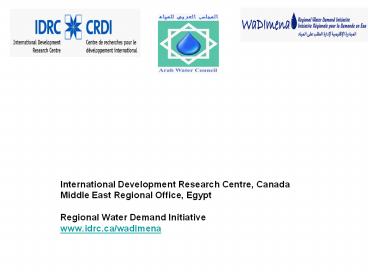International Development Research Centre, Canada - PowerPoint PPT Presentation
1 / 27
Title:
International Development Research Centre, Canada
Description:
?????? ????? ????? ??? ?????? ?? ??????? ??????? ... used for agribusiness export and bottled water are different uses that require ... – PowerPoint PPT presentation
Number of Views:56
Avg rating:3.0/5.0
Title: International Development Research Centre, Canada
1
?????? ????? ????? ??? ?????? ?? ??????? ???????
- International Development Research Centre, Canada
- Middle East Regional Office, Egypt
- Regional Water Demand Initiative
- www.idrc.ca/wadimena
2
Organization of the day
- Presentation of the region and countries
experience in demand management - Panel discussion
- Recommendations
3
(No Transcript)
4
Aim
- To engage a debate on water demand management,
the current status and the way forward
5
Objectives
- To reflect and debate the Arab region experience
and the main drivers and obstacles in
implementing Water Demand Management policies - Share knowledge and experience on best practices
in WDM in the region in both agriculture and
municipal water demand as a response to water
scarcity and emerging global challenges - Identify ways to promote water reforms to propel
WDM tools and strategies at the policy
formulation and implementation. - Identify further research, capacity building
needs and regional networking frameworks to
promote innovation in mechanisms needed to bring
WDM as a governance issue higher on the water
policy agenda
6
Water Demand Management (WDM)
- Refers to any measure that aims to
- improve the efficiency of water used to achieve a
specific task - adjust the nature of the task or the way it is
accomplished so that less water or less high
quality water is used - reduce losses in quantity and/or quality of water
flows from source through use to disposal and/or
shift the timing of use from peak to off-peak
periods. - WDM also includes measures to increase the
effectiveness of the water system to serve
society during times when water is in short
supply (e.g. drought). - D. Brooks (2004)
7
- WDM is simply getting the most from the water
that we have - Requires adequate technical, institutional,
regulatory and political backup to ensure - Social equity (access and responsible use)
- Economic efficiency
- Environment sustainability
8
Critical issues
9
MENA water challenges
- Scarcity of physical resources is chronic and
aggravated by - Inefficient use
- Reuse is not progressing as it should be
- High loss from the source to the point of use
- Scarcity of organizational capacity aggravated by
- Institutions roles and responsibilities
- Human resources
- Mutual accountability for achieving sustainable
water outcomes - Attitude and behaviour of the users, the
politicians and the society - Lack of awareness about the gains in water
saving, economic incentives Visible versus
invisible, understanding of what WDM is about
10
- Agree that we need to do something
- Do not agree on what and how to do it
11
- WDM is about changing the perception on water as
a finite and fragile resource that needs to be
valued, conserved and protected - The right of every citizen to access sufficient
quality and quantity is not put together with the
responsoble use of it - Water is like health it is priceless but it has a
cost tht can be minimized - The economic instruments are yet to be put in
their social context. Drinking water and water
used for agribusiness export and bottled water
are different uses that require different
approaches .
12
Sustainabilty of the resourcesCostly depletion
of GW Participation of Man and woman is akey to
change
WB 2007
13
Drop in level of the Souss Aquifer,
MoroccoExport agriculture has implication on
poor peasant livlihoods
14
- 30 km3 water loss in Countries from Morocco to
Lebanon in urban supply
15
Non revenue water Ratio for utilities
NRWR, is water loss, including unauthorized
consumption and metering inaccuracies and real
loss from leakage (distribution and service
connections.)
16
Operating cost coverage Ratio for Utilities in
selected cities in MENA region
17
Dynamic in policy
- Water law 10-95 Morocco
- Water Law in Yemen 2003
- KSA Water strategy started in 2003 and adopted in
2008 - Water Demand policy in Jordan 2008
- Water policy in Lebanon 2008
18
Bold steps in the right direction
19
(No Transcript)
20
Potential impact on MDGs
- Saving water is a two fold issue
- Saving investment for the government
21
Water saved provides access to the socially
disadvantaged segments
22
- Water saving is key to sustainability and health
of our ecosystems Enforcement of pollution
regulation
23
Cross subsidies and tariff blocks
24
Results take time to come
25
Quality of water policy and institution
The index covers the adequacy of the policy mix
(legislation, property rights and rationing or
allocation mechanisms) as well as instruments and
policies to control pollution
WB (2007)
26
What we do need
- To start with easy non controversial measures
- Better use through incentives and disincentives
- Decentralize decentralize decentralize
- Participation Participation Participation
- More and Better water reuse with regulation for
safety, economic impact and environment
externalities - Political will and backup
- Public awareness and societal engagement
- Social equity
- Stepwise process
- Institutional capacity building
- Water saving devices and building codes are yet
to be enforced
27
? ????































